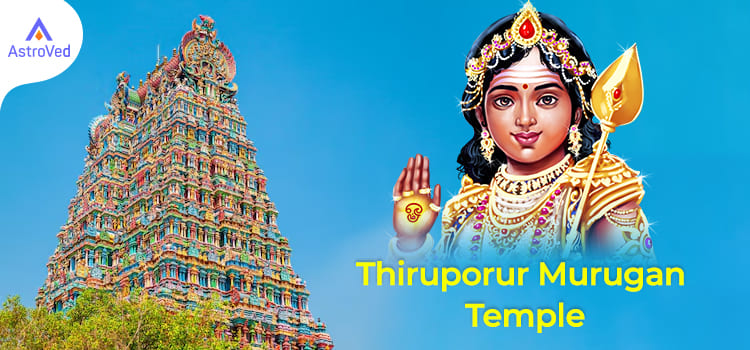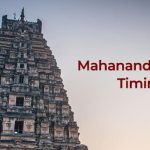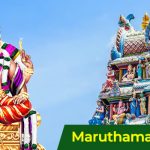Thiruporur Murugan Temple
Thiruporur Murugan Temple refers to the Kandaswamy (Muruga) Temple of Thiruporur, a panchayat in the Chengalpattu district of Tamil Nadu state. It is one of the most famous temples in the state, dedicated to Muruga, and lies about 40 km south of Chennai on Old Mahabalipuram Road.
Thiruporur Murugan Temple Legend
Muruga, the Divine son of Shiva, incarnated to rid the world of the cruelties of the demons. According to legends, he led the celestial army and fought with the demons, mainly at 3 places- in the sea at Tiruchendur, in the land at Thirupparankundram, and in the air at Thiruporur. Muruga took on and triumphed over the demon Tarakasura in this location; hence, this place came to be called Thiruporur. ‘Por’ in Tamil means war, and this location in which Muruga won the war became Thiru Por Ur, the Location of Muruga’s Victory. For the same reason, Thiruporur is also called Tharakapuri and Samarapuri.
The Temple legend also speaks about a deluge that submerged the place; then, a Divine voice directed a saint and Muruga devotee, Chidambara Adigal of Madurai, to unearth the Muruga statue lying below the layers of sand beneath a palm tree in this place. Adigal followed the Divine command, came to this place, pulled out the idol from the specified location, and built this Temple for Muruga, which is the Thiruporur Murugan Temple or Thiruporur Kandaswamy Temple of the present times. To commemorate this great service he rendered, they have made a separate shrine for Chidambara Adigal in the Thiruporur Murugan Temple and are bestowing him with special honors during Muruga’s birthday celebrations of the Vaikasi Visakam festival. The festival also ends with the depiction of Chidambara Adigal merging with Kandaswamy or Muruga, the presiding deity of the Temple.
According to beliefs, the great sage Agastya visited this place on his way to the Podhigai hills and prayed to the Lord.
Thiruporur Murugan Temple History and Architecture
The Thiruporur Murugan Temple is said to be initially a Pallava-era structure of the 10th century CE. It is also believed that Chidambara Swamigal, who came from the lineage of the Sangam poets, rebuilt the Temple in the 17th century. People also claim that this Temple was expanded in the 18th century when they could excavate some images at this place.
A 70-foot tall, 5-tier Rajagopuram, the principal tower, welcomes us to the Temple complex, spread across an area of about 4 acres. Inside, the devotees can approach the east-facing sanctum constructed with granite by passing through a 24-pillared hall. An imposing, 7-foot image of standing Muruga is consecrated in the sanctum as the presiding deity, Kandaswamy. He has 2 hands, in one of which he holds the mighty Vel, the Divine lance, while there is an image of a peacock, his Divine mount, near him. His consorts, Valli and Deivaanai, are housed in separate shrines in the first precinct; likewise, people can also worship Muruga’s Divine parents, Shiva and Parvati, and attendant deities usually found in the Shiva Temples, in their own shrines here. There is a Temple tank outside the premises.
Thiruporur Murugan Temple Religious Significance
It is believed that human beings did not make the idol of the principal deity Kandaswamy, but it is Swayambu, which originated on its own; hence, the priests do not perform ablution or hydration ceremonies to it, unlike the practice in other Temples. Instead, there is a Yantra, the geometric diagram with immense spiritual powers engraved on a metallic sheet mounted on a tortoise base, to which they perform the rituals.
There is also a belief that the main idol of Thiruporur Murugan Temple was discovered under a palm leaf. They are maintaining a palm leaf in the Temple, which, they claim, is this original leaf.
While Chidambara Swamigal, closely associated with the Temple, has sung 726 verses about this Lord Kandaswamy, the great saint-poet Arunagirinathar of the 16th century, has glorified Thiruporur Murugan Temple in his famous Thiruppugazh composition. Poet Baaladevaraya, in his much-revered Kanda Shasti Kavacham, has referred to the Muruga here as ‘Samaraapuri Vaazh Shanmugath Arase,’ the six-faced Lord of Samarapuri (Thiruporur).
Thiruporur Murugan Temple Festivals and Worships
They celebrate all occasions significant in Muruga’s life and exploits enthusiastically in the Thiruporur Murugan Temple. These include Vaikasi Visakam, Muruga’s Birthday, observed during Vaikasi Tamil month (May-June), and Kanda Shasti, the 6th Moon of Muruga’s ultimate triumph over the demonic forces, held during Aippasi Tamil month (October-November). They also hold Brahmothsavam, the annual festival during the Masi Tamil month (February-March), and celebrate the 9-day Navaratri festival. Devotees also perform ritualistic worships like carrying Paal Kudam, Paal Kaavadi, etc., mainly during the harvest festival of Pongal.
Apart from these festivals, they also do daily worship to the deity 4 times a Day- in the morning, noon, evening, and night.


